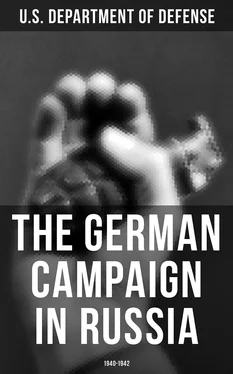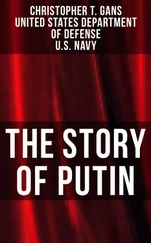On 5 February for instance, General der Infanterie (Lt. Gen.) Georg von Sodenstern, Chief of Staff, Army Group South, conducted a command post exercise in which the operation plan, so far as it pertained to his army group, was put to the test. The participants were the chiefs of staff and operations officers of the armies and corps assigned to Army Group South. The outcome of the exercise revealed the difficulty of effecting an envelopment east of the Dnepr because the Russian forces remaining in the Pripyat area could easily interfere with the progress of the northern arm of the pincers. Another lesson learned was that a number of faulty assembly movements would impede the execution of the initial maneuvers. The necessary changes in the plans were made on the spot. General Halder, who attended the exercise, expressed his satisfaction with the excellent presentation and fruitful discussion.
At this time the question of infantry-armor cooperation during the initial breakthrough was also the subject of particular attention. It was resolved by the decision of the Army High Command to place one infantry corps under the operational control of each panzer group during the initial assault phase. The infantry's mission was to open gaps for the armored forces which would emerge suddenly, thus achieving complete surprise. An additional advantage was that the armored units would thus be able to keep their full striking power for thrusting deep into the Russian theater. As soon as the panzer groups had advanced sufficiently, the infantry corps would revert to the control of their respective armies.
In February General Jodl and his associates in the Armed Forces High Command prepared propaganda material for the invasion, drafted special regulations pertaining to the administration of occupied Russian territories, drew up plans for military cooperation with those nations which had expressed their willingness to join Germany against the Soviet Union, and coordinated functions pertaining to two or more of the armed services. On 20 February Goering formed a small Luftwaffe planning staff and set it up under his own supervision near Berlin.
At the beginning of March logistical exercises took place at Army High Command headquarters, and Army Group South held a supply and administration game based on the lessons learned during Sodenstern's command post exercise of the preceding month. During the following weeks the Armed Forces and Army High Commands issued a series of directives and regulations pertaining mainly to supply and administration.
Changes in Plans
(March-April 1941)
Table of Contents
Table of Contents
On 18 March Hitler decided that Sixth Army was to carry out the main thrust of Army Group South. The plan for a Twelfth Army advance from Moldavia toward the northeast was abandoned. The German and Romanian units assembling along the Pruth were to tie down the opposing forces and pursue them only in the event that they should withdraw. This change in plan had to be made because Hitler contended that the Dnestr was a formidable obstacle that could not be surmounted by a frontal attack without considerable delay. According to the new plan the powerful left of Army Group South was to punch its way to the Kiev area and approach the Dnestr line from the rear. The forces assembled in Moldavia would have to be sufficiently strong to prevent a Russian penetration into Romania, but this danger did not seem acute since Brauchitsch had expressed the opinion that the Russians would not attack Romania unless they were attacked from Romanian territory. According to Hitler, Hungary was to take no part in Operation BARBAROSSA, and Slovakia was to assist only in the concentration and supply of German troops.
The Yugoslav coup d'etat on 26 March induced Hitler to expand the operations in the Balkans by attacking Yugoslavia in addition to Greece. The greater scope of the campaign in the Balkans necessitated that an army headquarters assume control of the occupied territories after the end of hostilities. Twelfth Army, which was in charge of the operations against Greece, was selected for this role, and Eleventh Army was designated as substitute headquarters for the forces assembled in Moldavia.
On 30 March 1941 the army group and army commanders reported to Hitler. During this conference the mission of Eleventh Army was discussed, and Hitler ordered the army forces divided into three separate groups, capable of backing up the Romanian divisions in case of need. Since Eleventh Army had thus been given a defensive mission, the motorized forces originally earmarked for that area were transferred to First Panzer Group. The encirclement of the Russian forces in the western Ukraine was to be effected by a single envelopment from the north, during which the armored forces were to thrust to the Dnepr at and south of Kiev, bear southeastward, and follow the bend of the river to its mouth, thus preventing the Russian forces in the western Ukraine from withdrawing across the river.
As a result of the foregoing changes, Directive No. 21 had meanwhile been amended as follows:
Section II, paragraph 3: In conjunction with the German troops assembled on Romanian territory, Romanian troops will tie down the enemy forces opposite their borders and will also lend assistance in maintaining the lines of communications.
Section III, A., paragraph 6: The army group committed south of the Pripyat Marshes will concentrate its main-effort forces in and to the south of the Lublin area for an attack in the general direction of Kiev. From there strong armored forces will thrust deep into enemy territory and envelop the Russian forces by following the course of the lower Dnepr.
The mixed German-Romanian force in the south will have two missions:
1. To secure Romania as a base and thus guarantee the continuity of operations in the southern part of the theater; and
2. To tie down the opposing enemy forces during the advance of the army group's north wing. In accordance with developments in the situation, the mixed force — supported by Air Force contingents — will launch a pursuit to prevent the Soviets from making an organized withdrawal across the Dnepr.
The corresponding changes were also incorporated into the Army's operation order. [See map 5 .] Army Group South was no longer to concentrate its strength on both its wings; instead, it was to strengthen its left so that mobile forces could pace the drive on Kiev, where they were to bear southeastward and destroy — or at least cut off — all enemy forces still in the western Ukraine.
The missions of the individual armies were changed as follows:
Eleventh Army was to protect Romania against an invasion by Russian troops, tie down the forces opposite the Romanian border by tricking the enemy into believing that major forces were being assembled, and eventually launch a pursuit to prevent the Russians from making an organized withdrawal.
Seventeenth Army was to jab with its powerful left, push back the enemy southeastward, and pursue him via Vinnitsa and Berdichev.
First Panzer Group was to thrust via Berdichev and Zhitomir toward the Dnepr River at Kiev, and then immediately continue its southeastward drive in order to block the Russian routes of withdrawal.
Sixth Army was to screen the north flank of the army group along the Pripyat Marshes and follow First Panzer Group closely up to Zhitomir. Upon receiving specific orders from army group, Sixth Army was to shift strong forces southeastward along the west bank of the Dnepr and join First Panzer Group in the destruction of the Russian forces fighting in the western Ukraine.
The difficulties of such an operation, hinging on a single envelopment, were fully realized by the Army High Command. Its success depended essentially upon whether the Russian leaders would react swiftly to the situation. If they recognized the danger in time, major Russian forces would probably get across the Dnepr River — or at least those opposite the Romanian border. The outcome of the offensive in the south therefore seemed doubtful from the outset.
Читать дальше












